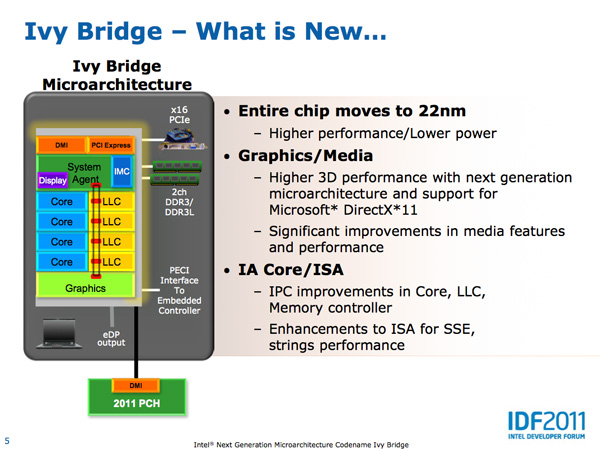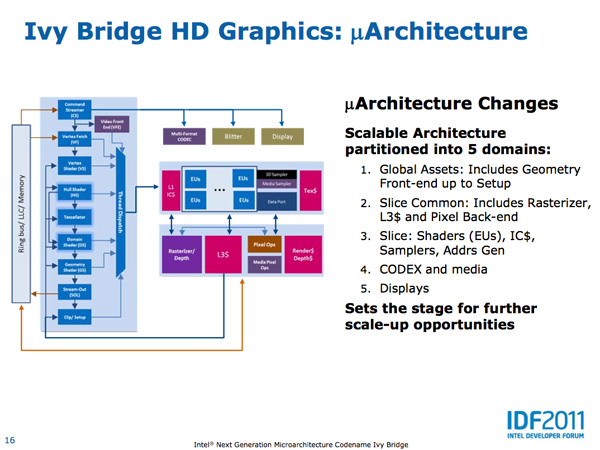The Ivy Bridge Preview: Core i7 3770K Tested
by Anand Lal Shimpi on March 6, 2012 8:16 PM EST- Posted in
- CPUs
- Intel
- Core i7
- Ivy Bridge
Ivy Bridge Architecture Recap
At IDF Intel disclosed much of Ivy's CPU architecture, but below is a quick summary:
- 4-wide front end with µOp cache from Sandy Bridge
- OoO execution engine from Sandy Bridge
- Data structures previously statically shared between threads can now be dynamically shared (e.g. DSB queue), improves single threaded performance
- FP/integer divider delivers 2x throughput compared to Sandy Bridge
- MOV instructions no longer occupy an execution port, potential for improved ILP when MOVs are present
- Power gated DDR3 interface
- DDR3L support
- Max supported DDR3 frequency is now 2800MHz (up from 2133MHz), memory speed can be moved in 200MHz increments
- Lower system agent voltage options, lower voltages at intermediate turbo frequencies, power aware interrupt routing
- Power efficiency improvements related to 22nm
- Configurable TDP
I've highlighted the three big items from a CPU performance standpoint. Much of the gains you'll see will come from those areas coupled with more aggressive turbo frequencies.


On the GPU, the improvements are more significant. Some of the major changes are below:
- DirectX 11 Support
- More execution units (16 vs 12) for GT2 graphics (Intel HD 4000)
- 2x MADs per clock
- EUs can now co-issue more operations
- GPU specific on-die L3 cache
- Faster QuickSync performance
- Lower power consumption due to 22nm






















195 Comments
View All Comments
The0ne - Wednesday, March 7, 2012 - link
"There's not enough of an improvement to make existing SNB owners want to upgrade, but if you're still clinging to an old Core 2 (or earlier) system, Ivy will be a great step forward."Basically all the laptops in the last few years for business have been bought with C2D. I think with Ivy, it's a great time to upgrade them all and see a good improvement. Same for family members too. I can't wait to try them out! Thanks for the review Anand.
benjaminbldp - Thursday, March 8, 2012 - link
maybe intel should drop the graphics all together, i don't like it, let the pro take care of it. just too much.dr/owned - Thursday, March 8, 2012 - link
This article blows because there's no overclocking results. We're not looking for a fine tuned overclock. Just give us the rough and dirty! My money is on 5 ghz with minimal effort using an air cooler.dagamer34 - Thursday, March 8, 2012 - link
It's a preview, not a review.dr/owned - Thursday, March 8, 2012 - link
It seems like Intel has the tick-tocks backwards. The i7-920 is arguably the greatest cpu to come out in recent years and it was "just" a tick.Wardrop - Thursday, March 8, 2012 - link
I'm afraid you have it backwards.The i7-920 is a Nehalem processor (it's a 45nm chip). It's a tock. Why is this concept so hard to grasp?
bigboxes - Thursday, March 8, 2012 - link
Look at the chart. Nehalem (i920) was a tock.just4U - Thursday, March 8, 2012 - link
I have to disagree with you on the i920 being such a huge leap. As someone who goes thru virtually every cpu line up for AMD/Intel I'd have to say the C2D (or quad) 6x series was the biggest leap forward in the past decade. Before that it was the A64 and X2 variants (altho.. we didn't get alot of use out of those secondary cores)IntelUser2000 - Thursday, March 8, 2012 - link
LOL, this must be the most hilarious argument I've heard in a while.How do you relate 30+ % graphics gain as being ALL CPU? Don't be ridiculous, and that's an understatement.
Silma - Thursday, March 8, 2012 - link
Are low-res testing really relevant for graphics?Most players play at 1920x1080 or higher.
1368x720 or 1680x1050 does not seem relevant to me at all for most people, especially those purchasing a computer with this processor.